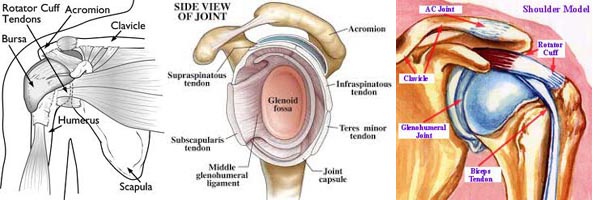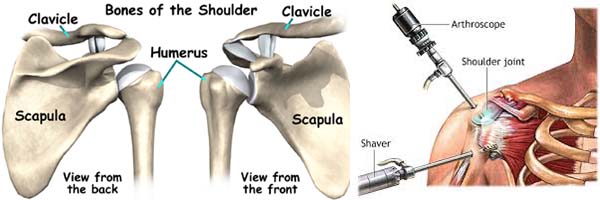What is Shoulder Arthroscopy ?
The arthroscope is a fiber optic instrument which is put into the shoulder joint through a small incision. A camera is attached to the arthroscope and the image is viewed on a TV monitor. The arthroscope allows us to fully evaluate the entire shoulder joint, including the ligaments, the rotator cuff, the biceps tendon, the joint lining and the cartilage surface.
Small instruments 4 millimeters in size are inserted through additional incision so that one can feel the joint structures for any damage, diagnose the injury and then repair or remove the damaged tissue.
Before the development of Arthroscopy, large incisions had to be made over the shoulder joint to treat or diagnose injuries. Today’s arthroscopic techniques allow more complete evaluations of the shoulder joint while accelerating the rehabilitation process.
Anatomy
Shoulder is a complex joint that is capable of more motion than any other joint in your body. It is made up of three bones: upper arm bone (humerus), shoulder blade (scapula), and collarbone (clavicle).

Ball and socket. The head of upper arm bone fits into a rounded socket in shoulder blade. This socket is called the glenoid. A slippery tissue called articular cartilage covers the surface of the ball and the socket. It creates a smooth, frictionless surface that helps the bones glide easily across each other.
The glenoid is ringed by strong fibrous cartilage called the labrum. The labrum forms a gasket around the socket, adds stability, and cushions the joint.
Shoulder capsule. The joint is surrounded by bands of tissue called ligaments. They form a capsule that holds the joint together. The undersurface of the capsule is lined by a thin membrane called the synovium. It produces synovial fluid that lubricates the shoulder joint.
Rotator cuff. Four tendons surround the shoulder capsule and help keep arm bone centered in shoulder socket. This thick tendon material is called the rotator cuff. The cuff covers the head of the humerus and attaches it to shoulder blade.
Bursa. There is a lubricating sac called a bursa between the rotator cuff and the bone on top of shoulder (acromion). The bursa helps the rotator cuff tendons glide smoothly when you move your arm.
When Shoulder Arthroscopy Is Recommended
Your doctor may recommend shoulder arthroscopy if you have a painful condition that does not respond to nonsurgical treatment. Nonsurgical treatment includes rest, physical therapy, and medications or injections that can reduce inflammation. Inflammation is one of your body's normal reactions to injury or disease. In an injured or diseased shoulder joint, inflammation causes swelling, pain, and stiffness.
Injury, overuse, and age-related wear and tear are responsible for most shoulder problems. Shoulder arthroscopy may relieve painful symptoms of many problems that damage the rotator cuff tendons, labrum, articular cartilage, and other soft tissues surrounding the joint.
What kind of procedures can be performed with the Arthroscopy :

- Repair for recurrent shoulder dislocation
- Removal or repair of the labrum
- Rotator cuff repair
- Bone spur removal
- Repair of ligaments
- Removal of inflamed tissue or loose cartilage
Less common procedures such as nerve release, fracture repair, and cyst excision can also be performed using an arthroscope.
Planning for Surgery
What Kind of anesthesia is used ?
combination of general anesthesia and regional anesthesia is used.
Surgical Procedure
Your surgeon will first inject fluid into the shoulder to inflate the joint. This makes it easier to see all the structures of your shoulder through the arthroscope. Then your surgeon will make a small puncture in your shoulder (about the size of a buttonhole) for the arthroscope. Fluid flows through the arthroscope to keep the view clear and control any bleeding. Images from the arthroscope are projected on the video screen showing your surgeon the inside of your shoulder and any damage.
Once the problem is clearly identified, your surgeon will insert other small instruments through separate incisions to repair it. Specialized instruments are used for tasks like shaving, cutting, grasping, suture passing, and knot tying. In many cases, special devices are used to anchor stitches into bone.
Your surgeon may close your incisions with stitches and cover them with a large, soft bandage.

Recovery
How long will I be in the Hospital ?
Almost all patients are discharged on the next day of surgery.
At Home
Although recovery from arthroscopy is often faster than recovery from open surgery, it may still take weeks for your shoulder joint to completely recover.
You can expect some pain and discomfort for at least a week after surgery. Ice will help relieve pain and swelling. Your doctor may prescribe pain medicine, if needed.
You will most likely need a sling or special immobilizer to protect your shoulder. Your surgeon will discuss with you how long the sling will be needed.
Rehabilitation
Rehabilitation plays an important role in getting you back to your daily activities. An exercise program will help you regain shoulder strength and motion. Your surgeon will develop a rehabilitation plan based on the surgical procedures you required.
It is important that you make a strong effort at rehabilitation in order for your surgery to succeed.
When can I return to sports ?
Your return to sports will depend on the extent of damage and the procedure performed to your shoulder. In general, you will be allowed to return to sports in 2 to 6 months after surgery. You must have good motion, strength and control of your shoulder and arm. How quickly you return to sports depends on several factors, including:
- Your own rate of healing.
- The damage found at surgery.
- How well you follow the post operative instructions.
- How hard you work in rehabilitation.
Long-Term Outcomes
Because patients have varied health conditions, complete recovery time is different for everyone.
If you have had a minor repair, you may not need a sling and your strength may return after a short period of rehabilitation. You may be able to return to work or school within a few days of your procedure.
It takes longer to recover from more complicated procedures.
Our commitment:
The entire Ayushman Department of Orthropaedice and sports medicine team is committed to you, the patient. We understand that you may be anxious about your injury and the need for surgery. Please contact me with any questions about your injury or treatment plan.